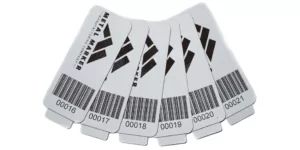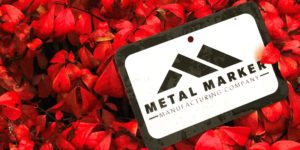For many industrial organizations, their office extends beyond just the walls of their company building. Construction firms have job sites, oil workers have refineries and off-shore platforms, and telecom workers have their utility poles and wires on every street coast to coast.
These are just a few of numerous enterprises which rely on identification tags and nameplates for marking their equipment, tools, and other assets. These applications leave equipment (and the nameplates which are attached) exposed to outdoor conditions.
Outdoor ID tags are durable enough to withstand all of the harsh environmental conditions which are thrown at them
Applications
Industrial
Industrial-type applications are not limited to the confines of an indoor manufacturing facility.
For example, construction workers rely on metal identification plates on their equipment to help serve as a guide for machine weight tolerances and equipment limitations. This type of environment is constantly exposed to everything from dust and debris to weather and abrasion.
Outdoor Signage
In addition to marking equipment and tools, metal identification is also used for industrial signage. Many factories and plants utilize signage and labels on the outside of their buildings.
This includes external production elements such as pumps, fuel tanks, and gas lines, as well as safety information.
Outdoor signage not only helps reinforce good habits for workers, but also protects visitors to the site who may not even be aware of policies, risks, or potential hazards which they are exposed to.
The best policy is to provide too much information than not enough.
Asset Tagging
Many industries utilize some form of asset traceability. This can be as simple as a serialized number attached to tools and equipment, or as sophisticated as a dedicated tracking software with barcode scanning for instant data access.

While you may typically picture a warehouse inventory system or a manufacturing plant, there are many industries whose assets are not confined to an indoor facility. Assets such as cranes and construction equipment are just as vital to a construction firm as a widget producing machine is to a manufacturing firm.
These organizations can’t just throw a simple barcode sticker on their equipment and call it a day. They require a significantly more durable solution.
Durability
Outdoor ID tags have one major focus: durability. Nameplates that are permanently outdoors are exposed to a wide range of harsh conditions.
Selecting the right process and material is key for a long-lasting solution.
Weather
While we try to stay out of inclement weather (if possible), nameplates don’t get the same luxury. From utility meters to vineyard posts and trees, tags are often left to the elements.
Rain, wind, extreme temperatures, and sunlight exposure can wreak havoc on a non-durable ID solution. Case in point, nameplates printed with a topical ink are prone to wear from the rain as well as heavy fading from UV sunlight. Whereas, formed tags (stamping, embossing) don’t have ink to wear or fade.

In addition, since weather varies heavily by location, keep this in mind as well. If you know your tags will be exposed to frequent rain, select a material and process suited for that environment.
Utility poles are an outdoor asset 365 days a year. It doesn’t matter if it rains, snows, freezes, or thaws; they are expected to work through all of it. The same holds true for the identification tags which adorn them.
This application typically calls for serialized embossing, as this is a highly durable process.
If you tried using paper to mark telephone poles, the information would be gone within a few days. This is why metal outdoor tags are so practical.
Materials
As mentioned, selecting a metal substrate for your identification needs is a step in the right direction toward a long term marking solution.
Some of the most commonly used materials for outdoor ID tags include:
- Anodized Aluminum
- Stainless Steel
- Cold Rolled Steel
- Brass
Process Options
In addition to selecting the right material, selecting a durable process is absolutely crucial if the nameplates will be used in an outdoor environment.
As a general rule, avoiding topical inks is preferred for outdoor use. Processes such as screen printing just aren’t best suited for these applications.
Some of the most durable processes include: embossing, stamping, and photo anodization.
Embossing
Often used for utility poles and other outdoor asset markings, embossing’s raised characters are sturdy enough to resist wear from the elements.
Stamping
Similar to embossing, stamped tags feature indented designs which are easy to read and can be customized with logos or other information with a custom stamp if necessary. A preferred method for survey markers, this process is suitable for harsh conditions.
Photo Anodization
An all-around solution, photo anodization provides the appearance of a black printed tag, with the durability of a pressed one. Metal tags made using this process are rated for 20+ years in outdoor conditions.
These tags also offer adding any information, design, or even logos and barcodes to your finished solution.
Wrap Up
Outdoor ID tags are a preferred solution for organizations which mark items in challenging environments. The nameplates have the toughness to hold up to weather, chemicals, and more.
From photo anodization to serialized embossing, there is a perfect solution for every outdoor application.